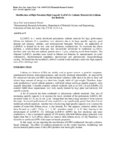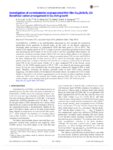|
|
Creator | Title | Description | Subject | Date |
| 1 |
 |
Smith, Grant D. | Viscoelastic properties of polybutadiene in the glassy regime from molecular dynamic simulations | A thorough understanding of the dynamic?mechanical properties of polymer melts and glasses is key to many, if not most, applications of polymers as well as to the processing of polymers. | Polymer melts; Polymer glasses; Molecular dynamic simulations | 2002 |
| 2 |
 |
Smith, Grant D. | Prediction of the linear viscoelastic shear modulus of an entangled polybutadiene melt from simulation and theory | While accurate quantum chemistry based potentials,1 improved simulation algorithms, and faster computers have made accurate calculation of chain dynamics in unentangled polymer melts from molecular dynamics simulations possible,2-5 direct calculation of the viscoelastic properties of entangled polym... | Polybutadiene melt; Viscoelastic shear; Chain dynamics; Entangled polymers | 2000 |
| 3 |
 |
Smith, Grant D.; Bedrov, Dmitro; Borodin, Oleg | Quantum-chemistry-based potential for poly(ester urethane) | We have carried out extensive high-level quantum chemistry studies of the geometry, charge distribution, conformational energies, and hydrogen-bonding energies of model compounds for a family of Estane thermoplastic urethanes (TPUs). Upon the basis of these studies, we have parametrized a classical ... | Estane thermoplastic urethanes; TPU; Charge distribution; Confromational energy | 2003 |
| 4 |
 |
Smith, Grant D. | Quantum chemistry based force field for simulations of poly(vinylidene fluoride) | A classical potential function for simulations of poly(vinylidene fluoride) (PVDF) based upon quantum chemistry calculations on PVDF oligomers has been developed. Quantum chemistry analysis of the geometries and conformational energies of 1,1,1,3,3-pentafluorobutane (PFB), 1,1,1,3,3,5,5,5-octofluoro... | Poly(vinylidene fluoride) simulations; PVDF | 2000 |
| 5 |
 |
Pugmire, Ronald J. | Investigation of the structural conformation of biphenyl by solid state 13C NMR and quantum chemical NMR shift calculations | The principal values of the 13C chemical-shift tensor (CST) for biphenyl have been determined with the FIREMAT experiment. The internal dihedral angle between the benzene rings in biphenyl is estimated to fall between 10 and 20° on the basis of quantum mechanical calculations of the CST principal v... | Carbon-13; Chemical-shift tensor; biphenyl; FIREMAT | 2001 |
| 6 |
 |
Borodin, Oleg; Smith, Grant D.; Bedrov, Dmitro | Polarizable and nonpolarizable force fields for alkyl nitrates | Quantum-chemistry-based many-body polarizable and two-body nonpolarizable atomic force fields were developed for alkyl nitrate liquids and pentaerythritol tetranitrate (PETN) crystal. Bonding, bending, and torsional parameters, partial charges, and atomic polarizabilities for the polarizable force f... | Alkyl nitrate; Pentaerythritol tetranitrate; PETN; Polarizable atomic force fields; Nonpolarizable atomic force fields | 2007 |
| 7 |
 |
Smith, Grant D.; Bedrov, Dmitro | NMR experiments and molecular dynamics simulations of the segmental dynamics of polystyrene | We have performed NMR spin?lattice relaxation experiments and molecular dynamics (MD) computer simulations on atactic polystyrene (a-PS). The segmental correlation times of three different molecular weight a-PS (Mn = 1600, 2100, 10 900 g/mol) were extracted from NMR by measuring the 2H spin?lattice ... | | 2004 |
| 8 |
 |
Bedrov, Dmitro; Borodin, Oleg; Smith, Grant D. | Comment on "On the accuracy of force fields for predicting the physical properties of dimethylnitramine" | Zheng and Thompson have recently reported a comparison of three atomistic force fields for prediction of physical properties of dimethylnitramine (DMNA) from molecular dynamics (MD) simulations.1 Specifically, they compared the rigid molecule force field by Sorescu, Rice, and Thompson (SRT);2 the ge... | | 2007 |
| 9 |
 |
Smith, Grant D.; Bedrov, Dmitro | Quantum-chemistry-based force field for simulations of dimethylnitramine | The molecular geometries and conformational energies of nitramide and dimethylnitramine (DMNA), determined from high-level quantum chemistry calculations, have been used in parametrization of a classical potential function suitable for simulations of DMNA. A thorough investigation of basis set size ... | Dimethylnitramine simulations; DMNA; Nitramide; Force field; Molecular dynamics simulations | 1999 |
| 10 |
 |
Smith, Grant D.; Borodin, Oleg; Bedrov, Dmitro | 13C NMR spin-lattice relaxation and conformational dynamics in a 1,4-polybutadiene melt | We have performed molecular dynamics (MD) simulations of a melt of 1,4-polybutadiene (PBD, 1622 Da) over the temperature range 400?273 K. 13C NMR spin?lattice relaxation times (T1) and nuclear Overhauser enhancement (NOE) values have been measured from 357 to 272 K for 12 different resonances. The T... | Polybutadiene melt; 13C NMR; Spin-lattice relaxation; Conformational dynamics; Molecular dynamics simulation | 2001 |
| 11 |
 |
Smith, Grant D. | Quantum chemistry based force field for simulations of HMX | The molecular geometries and conformational energies of octahydro-1,3,5,7-tetranitro-1,3,5,7-tetrazocine (HMX) and 1,3-dimethyl-1,3-dinitro methyldiamine (DDMD) and have been determined from high-level quantum chemistry calculations and have been used in parametrizing a classical potential function ... | HMX simulations; Molecular geometries; Conformational energies; DDMD | 1999 |
| 12 |
 |
Smith, Grant D. | Conformational properties of poly(vinylidene fluoride). A quantum chemistry study of model compounds | The molecular geometries and conformational energies of model molecules of poly(vinylidene fluoride) (PVDF) have been determined from high-level quantum chemistry calculations and have been used in parametrization of a six-state rotational isomeric state (RIS) model for PVDF. The model molecules inv... | Poly(vinylidene fluoride); PVDF; Conformational properties | 1999 |
| 13 |
 |
Smith, Grant D. | Molecular dynamics of a 1,4-polybutadiene melt. Comparison of experiment and simulation | We have made detailed comparison of the local and chain dynamics of a melt of 1,4-polybutadiene (PBD) as determined from experiment and molecular dynamics simulation at 353 K. The PBD was found to have a random microstructure consisting of 40% cis, 50% trans, and 10% 1,2-vinyl units with a number-av... | Polybutadiene melt; Molecular dynamics | 1999 |
| 14 |
 |
Liu, Feng | Self-organized nanoscale pattern formation on vicinal Si(111) surfaces via a two-stage faceting transition | We demonstrate a self-organized pattern formation on vicinal Si(111) surfaces that are miscut toward the [211] direction. All the patterns, consisting of a periodic array of alternating (7 X 7) reconstructed terraces and step-bunched facets, have the same periodicity and facet structure, independent... | Vicinal Si(111); Nanoscale pattern formation; Two-stage; Faceting transition | 2002-02 |
| 15 |
 |
Liu, Feng | Equilibrium shape of two-dimensional islands under stress | We show that the equilibrium shape anisotropy of two-dimensional islands in heteroepitaxial growth depends on island size, a consequence of the presence of strain. Even in homoepitaxy, in which the island shape has conventionally been equated with the ratio of step energies, a substrate surface str... | Two-dimensional islands; Equilibrium shape; Heteroepitaxial growth; Homoepitaxy | 2000-08 |
| 16 |
 |
Scarpulla, Michael | Magnetocrystalline anisotropy and magnetization reversal in Ga1-xMnxP synthesized by ion implantation and pulsed-laser melting | We report the observation of ferromagnetic resonance (FMR) and the determination of the magnetocrystalline anisotropy in (100)-oriented single-crystalline thin film samples of Ga1−xMnxP with x=0.042. The contributions to the magnetic anisotropy were determined by measuring the angular and the te... | Magnetocrystalline anisotropy; GaMnAs; Gallium arsenide | 2007-06 |
| 17 |
 |
Liu, Feng | Computational R&D for industrial applications | Recent advances in high-speed supercomputer and computational algorithms have brought us into a new era of computational materials science. These advances make it possible to investigate many existing materials systems that were previously considered intractable and also predict and design novel mat... | Computational materials science | 2005 |
| 18 |
 |
Tiwari, Ashutosh | Modification of high potential, high capacity Li2FeP 2O7 cathode material for lithium ion batteries | Li2FeP2O7 is a newly developed polyanionic cathode material for high performance lithium ion batteries. It is considered very attractive due to its large specific capacity, good thermal and chemical stability, and environmental benignity. However, the application of Li2FeP2O7 is limited by its low i... | | 2012-01-01 |
| 19 |
 |
Scarpulla, Michael | Investigation of combinatorial coevaporated thin film Cu 2ZnSnS4 (II): Beneficial cation arrangement in Cu-rich growth | Cu2ZnSn(S,Se)4 (CZTSSe) is an earth-abundant semiconductor with potential for economical photovoltaic power generation at terawatt scales. In this work, we use Raman scattering to investigate phase coexistence in combinatorial CZTS thin films grown at 325 or 470 C. The surface of the samples grown a... | | 2014-01-01 |
| 20 |
 |
Stringfellow, Gerald B.;Inglefield, Colin E.;Taylor, P. Craig | Characterization of unicompositional GaInP2 ordering heterostructures grown by variation of V/III ratio | Photoluminescence (PL) and photoluminescence excitation (PLE) spectroscopies are employed to investigate single heterostructures based on two GaInP2 layers that have the same composition but different degrees of order on the cation sublattice. Four sample configurations are studied: two complemen... | Heterostructures; Growth parameters; Growth temperature | 1997 |
| 21 |
 |
Scarpulla, Michael | Grain size and texture of Cu2ZnSnS4 thin films synthesized by co-sputtering binary sulfides and annealing: effects of processing conditions and sodium | We investigate the synthesis of kesterite Cu2ZnSnS4 (CZTS) polycrystalline thin films using cosputtering from binary sulfide targets followed by annealing in sulfur vapor at 500 ?C to 650 ?C. The films are the kesterite CZTS phase as indicated by x-ray diffraction, Raman scattering, and optical abso... | | 2011 |
| 22 |
 |
Scarpulla, Michael | Detection of ZnS phases in CZTS thin-films by EXAFS | Copper zinc tin sulfide (CZTS) is a promising Earthabundant thin-film solar cell material; it has an appropriate band gap of ~1.45 eV and a high absorption coefficient. The most efficient CZTS cells tend to be slightly Zn-rich and Cu-poor. However, growing Zn-rich CZTS films can sometimes result in ... | | 2011-01-01 |
| 23 |
 |
Scarpulla, Michael | Near-infrared absorption and semimetal-semiconductor transition in 2 nm ErAs nanoparticles embedded in GaAs and AlAs | We report strong near-infrared absorption peaks in epitaxial films of GaAs and AlAs containing approximately 0.5-5% of the semimetal ErAs. The energy of the resonant absorption peak can be changed from 0.62 to 1.0 eV (2.2-1.4 μm) by variation of the ErAs volume fraction and the substrate temperatu... | Near-infrared absorption; Semimetal-semiconductor transition; GaAs; AlAs; ErAs; Gallium arsenide; Aluminum arsenide | 2008 |
| 24 |
 |
Liu, Feng | Modified Timoshenko formula for bending of ultrathin strained bilayer films | Mechanical bending of nanoscale thin films can be quite different from that of macroscopic thick films. However, current understanding of mechanical bending of nanoscale thin strained bilayer films is often limited within the Timoshenko model [Timoshenko, J. Opt. Soc. Am. 11, 233 (1925)], which was ... | Timoshenko formula; Bending theory; Ultrathin films; Strained nanoscale thin films; Nanofilms | 2008 |
| 25 |
 |
Liu, Feng | Stability of doubly charged transition-metal dimers | The spatial dependence of the interaction potentials in doubly charged dimers of transition-metal atoms has been calculated by use of both the tight-binding and the self-consistent-field linear combination of atomic orbitals-molecular orbitals methods. The study reveals an interesting correlation be... | Doubly charged; Transition metal dimers; Spatial dependence; Interaction potentials; Metastability | 1987-11 |

























